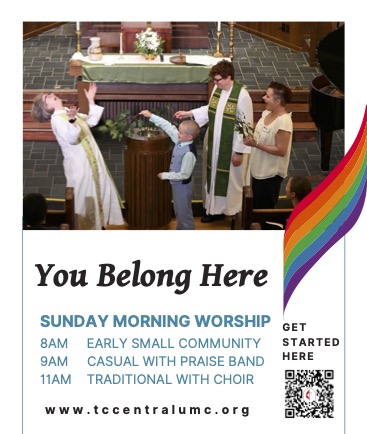
Boardman River Plan Unveiled
By Beth Milligan | Dec. 18, 2021
After three years of work and dozens of committee and public input meetings, the Lower Boardman Unified Plan – a master plan that will guide planning and improvement projects along the 1.6-mile stretch of Boardman River between Boardman Lake and Grand Traverse Bay – was unveiled to community leaders Friday.
The Traverse City Downtown Development Authority (DDA) board, which spearheaded the project in partnership with a leadership team consisting of more than a dozen community stakeholders, was the first group to see the final plan. “This is a momentous occasion,” said DDA CEO Jean Derenzy, noting the goal of the project was to “restore and reconnect the river to the downtown and to the community.” The Lower Boardman Unified Plan outlines steps for the DDA and city to “embrace the river and identify it as the great resource it is” instead of “turning our back” on the Boardman, Derenzy said.
Consulting group SmithGroup – using public feedback from numerous workshops and community input sessions on residents’ ideal vision for the urban section of the Boardman River – helped draft the plan. Leadership team member Pete Kirkwood said the plan ended up focusing on the primary themes of “culture, connectivity, and habitat.” Culture is defined as “focused learning and art to educate and inspire people about the Aanishinaabek and their history in the region,” connectivity defined as helping “people to recreate along, celebrate the value of, and learn about the Boardman River,” and habitat defined as “preservation and creation for aquatic, riparian, and avian communities to increase native species diversity and improve water quality,” according to the plan.
The plan calls for numerous improvement projects along the Boardman River, with the highest priority projects being the reconstruction of the north alleys in the 100 and 200 blocks of Front Street – allowing a new riverfront pedestrian plaza to be built in the 200 block alley – and upgrading the existing gravel path in Hannah Park. Adding new river boardwalk around Riverine Apartments and extending the boardwalk to Front Street are also near the top of the list. Moderate priority projects include improved access to Hannah Park, habitat restoration at multiple points of the river, new boardwalk and kayak portage options, and pocket parks and boardwalk connections along East Front Street.
The document also contains a summary of past planning projects related to the Boardman River and outlines core values for the river, such as prioritizing multi-modal access, ensuring consistency with best riparian/stormwater/aquatic science practices, managing invasive vegetation, and seeking consistency from waterfront developments in complying with the city’s renewable energy goals. The plan notes the city should resist further hardening of shorelines and “ensure that the natural flow of the river is enhanced and not curtailed or impended” by any improvement projects. It also includes zoning and land use recommendations, notes on river conditions and habitats, and opportunities for improvement in different riverfront zones, such as striving to have more buildings along Front Street have both street-facing and river-facing entrances to better connect downtown visitors to the Boardman.
Brett Fessell, co-chair of the leadership team and a river ecologist for the Grand Traverse Band of Ottawa and Chippewa Indians, read a statement from the team to the DDA board Friday. “No plan has power without commitment to its principles, expressed in actions,” he read. “The Unified Plan isn’t a cookbook of recipes for success. The success of the plan will rest on it being a predicate for ongoing, inclusive, open-minded conversations about how best to protect the river and reconcile competing uses of the river as the city grows and develops. The unified planning process has, we hope, helped to extend and focus those ongoing conversations.”
Derenzy said the Lower Boardman Unified Plan was not intended to “sit on the shelf,” saying its recommendations were “community led” and included specific “implementable projects.” One of those projects, the alley reconstruction, has already been prioritized for funding by the DDA board, Derenzy noted. The plan also divides the lower Boardman River into six sections, called “reaches,” which will allow the DDA to tackle improvements in phases as needed.
“We don’t have to do it all at once,” Derenzy said. “We can put it into sections.” One of the main takeaways from the project, according to Derenzy, is that city leaders recognize that the lower sections of the Boardman River can’t continue to be “disjointed” from each other and from the rest of downtown. “This is the time to really connect,” she said.
DDA board members voted unanimously Friday to approve the Lower Boardman Unified Plan. The plan next heads to the city’s parks and recreation commission, planning commission, and city commission for approval. The plan already appears to have city commission buy-in, as Mayor Richard Lewis – who sits on the DDA board – voted to approve the document Friday and two other city commissioners praised the document during public comment.
“I think the final product is excellent,” said Commissioner Tim Werner. “We’ve grown up as a city with our backs to the river, and now we want to turn to the front.” Commissioner Mitchell Treadwell agreed, saying he was impressed by the “long extensive public process” featuring a broad variety of community stakeholders that produced the Lower Boardman Unified Plan. Treadwell said the process made clear “how much of an asset the lower Boardman River is to our downtown, to our community, and to the region as a whole,” adding that he hoped having a renewed focus on the Boardman will bring in “a new future where we honor and respect the river.”
Comment






